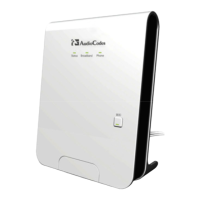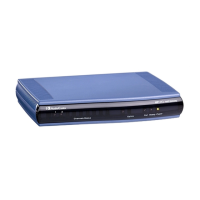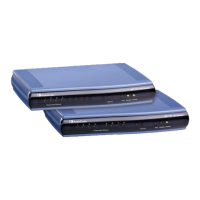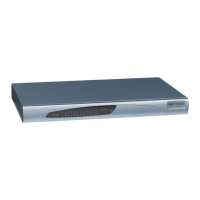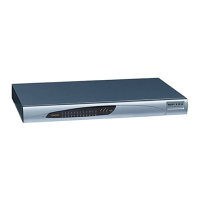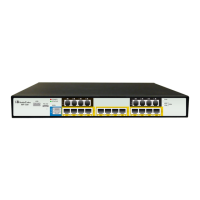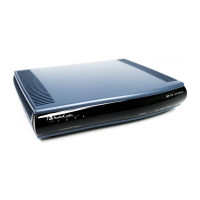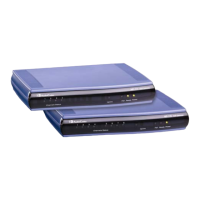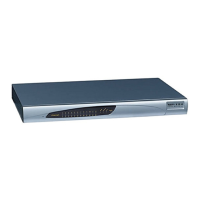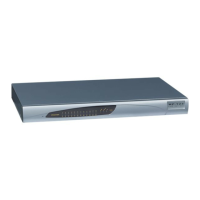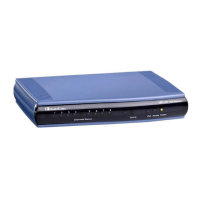Do you have a question about the AudioCodes MP-26 series and is the answer not in the manual?
| Ports | FXS |
|---|---|
| Number of FXS Ports | 2 |
| VoIP Protocols | SIP, H.323 |
| Fax Support | T.38, G.711 pass-through |
| Humidity | 10% to 90% non-condensing |
| Network Interface | Ethernet |
| Voice Codecs | G.711, G.723.1, G.726, G.729 |
| Management | Web-based, SNMP |
| Operating Temperature | 0°C to 40°C |
| Storage Temperature | -20°C to 70°C |
Highlights key features like ADSL2+/VDSL2 modem, Ethernet WAN, HD VoIP, and wireless connectivity.
Lists items included in the package: cables, power adapter, DECT handset and cradle.
Lists items not supplied but required for setup, such as Internet connection and analog telephones.
Details the device's ports, buttons, and LEDs on its front and rear panels.
Provides instructions and diagrams for correctly cabling the device to the Internet and peripherals.
Describes how to place the device on a desktop or mount it on a wall.
Outlines the initial steps to prepare the device for configuration, including cable connection and powering on.
Describes how to configure WAN access via xDSL, WAN Ethernet, or 3G USB Modem.
Provides steps to configure the Wi-Fi network, including SSID, security, and password settings.
Guides through the process of registering the DECT handset to the device base unit.
Explains how to access and log into the device's Web interface for configuration and monitoring.
Describes the different menus in the Web interface and their grouping of related themes.
Describes how to add new users, assign login credentials, and group users for preferences and access control.
Provides instructions on how to log out of the device's Web interface.
Describes the meaning and function of various icons displayed in the 'Map View' screen.
Describes how to configure computers for connecting via a LAN cable.
Guides on connecting computers to the device's wireless network using Wi-Fi.
Describes how to quickly set up an Internet connection using the Web interface's 'Quick Setup' screen.
Explains the Automatic Dialer feature for pre-configured Internet connection types.
Provides parameters to quickly set up a wireless (Wi-Fi) network.
Details the configuration of SIP parameters, including signaling protocol, proxy, and registrar settings.
Guides on configuring dialing parameters like timeout, number size, and DTMF settings.
Explains how to configure supplementary services like Call Waiting, Call Forwarding, and Auto Attendant.
Guides on configuring lines, which are logical SIP ID numbers for registering to a SIP proxy server.
Explains how to define arbitrary names for extensions and activate their registration.
Describes associating called party's parameters with a number for speed dialing.
Covers Bluetooth functionality, including pairing, unpairing, auto-connecting, and phonebook synchronization.
Provides step-by-step instructions on how to make a call using the analog telephone.
Explains how to answer a waiting call based on the configured flash-hook functionality.
Details how to put a call on hold, depending on the configured flash-hook functionality.
Describes how to transfer an established call to another destination.
Explains how to establish a 3-way conference call.
Guides through configuring QoS parameters by selecting profiles and defining WAN bandwidth.
Describes traffic shaping for managing network congestion, including bandwidth limits and prioritization.
Describes defining inbound and outbound priority rules for devices to manage traffic congestion.
Describes how to configure WAN Internet connections using a connection wizard.
Details the configuration of WAN DSL connection types.
Lists various WAN Ethernet connection types supported by the device.
Describes how to configure device LAN connections, including Wireless LAN and Ethernet switch.
Explains how to configure the device's wireless network.
Describes the LAN Hardware Ethernet Switch interface and its properties.
Explains how to edit network connections and perform additional configurations.
Explains how to create VLANs for LAN and WAN interfaces.
Explains how to configure LAN-WAN bridges.
Overviews remote configuration and management capabilities.
Explains default settings and remote configuration interfaces.
Covers remote management aspects like firmware upgrade and status monitoring.
Describes enabling secure remote access to manage the device.
Guides on configuring certificates for secure remote management.
Lists supported remote interfaces: Web GUI, TR-069, Syslog, file download, CLI.
Describes configuring basic security settings, including firewall levels.
Explains blocking specific computers or networks from accessing Internet services.
Details exposing network services to the Internet.
Describes designating a local computer as a DMZ host.
Explains configuring port triggering for dynamic port forwarding.
Guides on blocking access to specific Internet websites.
Details Network Address Translation (NAT) and NAPT mechanisms.
Explains defining specific rules for comprehensive control over firewall behavior.
Describes viewing the Security log for firewall events.
Explains the DHCP server for allocating IP addresses.
Details configuring DHCP server settings.
Describes configuring the device as a DHCP relay.
Describes managing the device's DNS server.
Explains the Dynamic DNS feature.
Describes configuring routing rules.
Explains how PPPoE relay works.
Describes UPnP for seamless device connectivity.
Provides steps to enable UPnP.
Explains making local services available to Internet PCs.
Describes the file server utility.
Covers configuring disk management for storage devices.
Describes configuring partitions and formatting storage devices.
Explains Redundant Array of Independent Disks (RAID) support.
Describes the print server utility.
Guides on setting up a network printer on Windows.
Compares IPP, Samba, and LPD protocols.
Explains how the Feature Key enables features.
Describes how to view software version and upgrade.
Guides on setting the phone's date, time, and daylight saving.
Covers configuring device backup facility.
Explains how to view, save, and load the device configuration file.
Details the mechanism for upgrading the device's software image.
Guides on configuring device system and management parameters.
Describes how to reboot the device.
Explains how to restore the device to factory default settings.
Allows testing network connectivity and viewing statistics.
Details how to run a ping test.
Describes how to view device performance statistics.
Details how to view statistical information about data.
Explains how to view the System Log.
Describes how to view CPU statistics.
Explains how to monitor VoIP traffic.
Lists error messages that may appear in the Web interface.
Highlights the main features of the DECT phone.
Provides essential safety instructions for using the DECT phone.
Guides on the initial setup of the DECT phone.
Details the physical installation of the DECT phone handset and cradle.
Explains how to charge the handset batteries.
Introduces the handset's physical layout and LCD screen.
Guides on upgrading the device and base unit software versions.
Describes defining the handset as a device phone line.
Provides instructions for registering the handset to the base unit.
Explains how the antenna icon indicates signal strength.
Describes how to make external calls.
Explains how to answer an incoming call.
Describes how to answer or reject a second incoming call.
Provides methods to end a call.
Details adjusting volume levels during a call.
Explains how to mute the handset's microphone.
Describes the Redial List functionality.
Explains how to lock the keypad.
Covers call handling between multiple handsets.
Guides on adding a new contact to the phonebook.
Explains how to edit existing contacts in the phonebook.
Describes how to view all contacts in the phonebook.
Explains how to delete all contacts from the phonebook.
Describes how to view missed, received, and redialed calls.
Guides on saving a number from the Call List to the phonebook.
Explains how to delete all entries from the Call List.
Describes setting the phone's date and time, and format.
Describes the built-in alarm clock features.
Details steps to set the alarm time and configure snooze.
Details adjusting speaker and earpiece volume levels.
Explains selecting ringer melodies and adjusting ringer volume.
Explains how to set the handset display language.
Explains activating or deactivating Auto Answer.
Describes resetting handset settings to factory defaults.
Covers renaming and de-registering a handset.
Details changing the PIN number for base unit settings.
Guides on resetting base settings to factory defaults.
Lists the default values for various settings.
Lists common problems, causes, and solutions.
Describes the operation of the Backup Battery Pack.
Provides safety instructions for the Backup Battery Pack.
Guides on connecting the Backup Battery Pack.
Details specifications of the Device Gateway and DECT phone.
Lists router and VoIP functionality specifications.
Provides specifications for the DECT phone.
